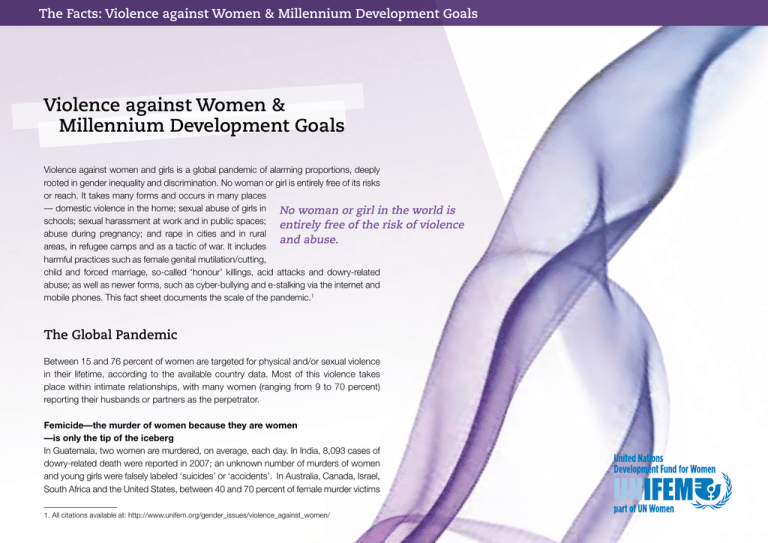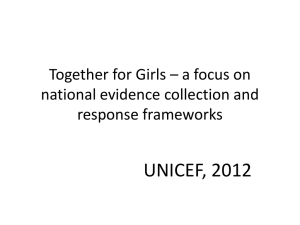
The Facts: Violence against Women & Millennium Development Goals
Violence against Women &
Millennium Development Goals
Violence against women and girls is a global pandemic of alarming proportions, deeply
rooted in gender inequality and discrimination. No woman or girl is entirely free of its risks
or reach. It takes many forms and occurs in many places
— domestic violence in the home; sexual abuse of girls in No woman or girl in the world is
schools; sexual harassment at work and in public spaces; entirely free of the risk of violence
abuse during pregnancy; and rape in cities and in rural
and abuse.
areas, in refugee camps and as a tactic of war. It includes
harmful practices such as female genital mutilation/cutting,
child and forced marriage, so-called ‘honour’ killings, acid attacks and dowry-related
abuse; as well as newer forms, such as cyber-bullying and e-stalking via the internet and
mobile phones. This fact sheet documents the scale of the pandemic.1
The Global Pandemic
Between 15 and 76 percent of women are targeted for physical and/or sexual violence
in their lifetime, according to the available country data. Most of this violence takes
place within intimate relationships, with many women (ranging from 9 to 70 percent)
reporting their husbands or partners as the perpetrator.
Femicide—the murder of women because they are women
—is only the tip of the iceberg
In Guatemala, two women are murdered, on average, each day. In India, 8,093 cases of
dowry-related death were reported in 2007; an unknown number of murders of women
and young girls were falsely labeled ‘suicides’ or ‘accidents’. In Australia, Canada, Israel,
South Africa and the United States, between 40 and 70 percent of female murder victims
1. All citations available at: http://www.unifem.org/gender_issues/violence_against_women/
were killed by their intimate partners. In the State of Chihuahua, Mexico, 66 percent of
murders of women were committed by husbands, boyfriends or other family members.
Young women are at high risk of violent assault
Worldwide, up to 50 percent of sexual assaults are committed against girls under
16. An estimated 150 million girls under the age of 18 suffered some form of sexual
violence in 2002 alone. The first sexual experience of some 30 percent of women was
forced. The percentage is even higher among those who were under 15 at the time of
their sexual initiation, with up to 45 percent reporting that the experience was forced.
Millions of girls around the world are subjected to harmful practices
Approximately 100 to 140 million girls and women in the world have experienced female
genital mutilation/cutting, with more than 3 million girls in Africa annually at risk of the practice.
Over 60 million girls worldwide are child brides, married before the age of 18, primarily
in South Asia (31.3 million) and sub-Saharan Africa (14.1 million). Violence and abuse
characterize married life for many of these girls. Women who marry early are more likely to
be beaten or threatened, and more likely to believe that a husband might sometimes be
justified in beating his wife.
Trafficking ensnares millions of women and girls in modern-day slavery
Women and girls are 80 percent of the estimated 800,000 people trafficked across
national borders annually, with the majority (79 percent) trafficked for sexual exploitation.
Within countries, many more women and girls are trafficked, often for purposes of
sexual exploitation or domestic servitude. One study in Europe found that 60 percent
of trafficked women had experienced physical and/or sexual violence before being
trafficked, pointing to gender-based violence as a push factor in the trafficking of women.
Sexual harassment occurs every day in workplaces, schools,
streets and public spaces
Between 40 and 50 percent of women in European Union countries experience
unwanted sexual advances, physical contact or other forms of sexual harassment
at work. Across Asia, studies in Japan, Malaysia, the Philippines and South Korea
show that 30 to 40 percent of women suffer workplace sexual harassment. In Nairobi,
20 percent of women have been sexually harassed at work or school. In the United
States, 83 percent of girls aged 12 to 16 experienced some form of sexual harassment
in public schools.
Almost 60 percent of women surveyed in Montreal, Canada reported that they were afraid
of walking alone in their neighborhood at night (compared to 17 percent of men). In a study
in Lima, Peru, only 12 percent of women reported that they could move freely without fear
of aggression.
Rape as a tactic of warfare is rampant
Conservative estimates suggest that 20,000 to 50,000 women were raped during the
1992-1995 war in Bosnia and Herzegovina, while approximately 250,000 to 500,000
women and girls were targeted for rape in the 1994 Rwandan genocide.
Between 50,000 and 64,000 women in camps for internally displaced people in Sierra
Leone were sexually assaulted by combatants between 1991 and 2001. In eastern
Democratic Republic of Congo, at least 200,000 cases of sexual violence, mostly
involving women and girls, have been documented since 1996: the actual numbers
are believed to be far higher.
Ending Violence against Women and Girls: ‘Missing Target’ of the MDGs?
Violence against women undermines efforts to realize the Millennium Development
Goals (MDGs), which 189 Heads of State and Government have committed to achieve
by 2015. While ending violence against women is a strategic priority for achieving
gender equality and the goals overall, it remains a ‘missing target’ of the MDGs.
Gender inequality and violence hamper countries’ efforts to reduce poverty
Women and girls are half of the human capital available to reduce poverty and achieve
development. Yet gender-based violence undermines human rights, social stability
and security, public health, women’s educational and employment opportunities,
and the well-being and development prospects of children and communities — all
fundamental to achieving the MDGs.
Violence against women reduces productivity and drains public budgets.
Violence against women has enormous direct and indirect costs for survivors, employers
and the public sector in terms of health, police, legal and related expenditures as well
as lost wages and productivity.
According to a study in India, a woman loses an average of at least 5 paid work days for
each incident of intimate partner violence, while in Uganda, about 9 percent of violent
incidents forced women to lose time from paid work, amounting to approximately 11
days a year.
Annual costs of intimate partner violence were calculated at US$5.8 billion in the
United States and US$1.16 billion in Canada. In Australia, violence against women
and children costs an estimated US$11.38 billion per year. In Fiji, the annual estimated
cost was US$135.8 million or 7 percent of the Gross Domestic Product in 2002.
Domestic violence alone cost approximately US$32.9 billion In England and Wales.
The costs and consequence of violence against women last for generations
Children who witness domestic violence are at increased risk of anxiety, depression,
low-self esteem and poor school performance, among other problems that harm their
well-being and personal development. In Nicaragua, 63 percent of children of abused
women had to repeat a school year and they left school on average 4 years earlier than
other children.
Children, both girls and boys, who have witnessed or suffered from gender-based
violence, are more likely to become victims and abusers later in life. For example,
surveys in Costa Rica, Czech Republic, Philippines, Poland and Switzerland revealed
that boys who witnessed their father using violence against their mother were 3 times
more likely to use violence against their partners later in life.
Sexual violence deprives girls of education
School-related violence limits the educational opportunities and achievements of girls.
In a study in Ethiopia, 23 percent of girls reported experiencing sexual assault or rape
en route to or from school. In Ecuador, adolescent girls reporting sexual violence in
school identified teachers as the perpetrator in 37 percent of cases. In South Africa, 33
percent of reported rapes of girls were perpetrated by a teacher. Many girls changed
schools or left school as a result of hostility after they reported the violence.
Violence harms reproductive, maternal and child health
Gender-based violence severely restricts women’s ability to exercise their reproductive
rights, with grave consequences for sexual and reproductive health.
As many as 1 in 4 women experience physical or sexual violence during pregnancy.
This increases the likelihood of miscarriage, stillbirth and abortion, as well as premature
labour and low birth weight. Between 23 and 53 percent of women physically abused
by their intimate partners during pregnancy are kicked or punched in the abdomen.
Violence limits women’s access to family planning, which can potentially decrease
maternal mortality by an estimated 20 to 35 percent by reducing women’s exposure to
pregnancy-related health risks.
Women who experience violence tend to have more children than they themselves
want. This not only shows how little control they have over decisions affecting their
sexual and reproductive lives, but also reduces the potential demographic benefits of
reproductive health, estimated to reduce poverty by 14 percent.
Harmful practices also damage maternal and child health. Child marriage resulting
in early and unwanted pregnancies poses life-threatening risks for adolescent girls:
pregnancy-related complications are the leading cause of death for 15-to-19-year-old
girls world-wide. Female genital mutilation/cutting increases the risks of obstructed
labour, childbirth complications, newborn deaths, postpartum bleeding, infections and
maternal mortality.
Up to 14.6 percent of women in sub-Saharan Africa and south-east Asia reported
that when they disclosed their HIV status, their intimate partners subjected them to
violence, and fear of violence is a barrier to women disclosing their status and accessing
appropriate care.
Life is dangerous for women and girls in city slums
Women in poor urban areas are especially at risk of physical and psychological
violence. They are twice as likely as men to experience violence, particularly in
developing countries. In São Paulo, Brazil, a woman is assaulted every 15 seconds.
MILLENIUM DEVELOPMENT GOALS (MDGs):
MDG 1: Eradicate extreme poverty and hunger
MDG 2: Achieve universal primary education
MDG 3: Promote gender equality and empower women
MDG 4: Reduce child mortality
MDG 5:Improve maternal health
Violence fuels the HIV and AIDS pandemic
Violence limits women’s ability to protect themselves from HIV, and women living with
HIV or AIDS are often the targets of abuse and stigma. Young women are at especially
high risk of both HIV and gender-based violence: they represent approximately 60
percent of all the 5.5 million young people in the world living with HIV and AIDS.
Women are already 2 to 4 times more likely than men to become infected with HIV during
intercourse, with forced sex or rape increasing this risk by limiting condom use and causing
physical injuries. In the United States, 11.8 percent of new HIV infections among women
over 20 during the previous year were attributed to intimate partner violence. Studies from
Tanzania, Rwanda and South Africa suggest that women who have experienced partner
violence are more likely to contract HIV than those who have not.
[Target 2 — Universal reproductive health access]
MDG 6: Combat HIV/AIDS, malaria and other diseases
MDG 7:Ensure environmental sustainability
[Target 4 — Significantly improve living conditions for slum dwellers]
MDG 8: Develop a global partnership for development






